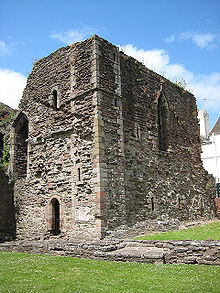- Monmouth Castle
-
Coordinates: 51°48′45.57″N 2°42′59.17″W / 51.8126583°N 2.7164361°W Monmouth Castle is a castle site in the town of Monmouth, county town of Monmouthshire, south east Wales.
Contents
Location
Monmouth Castle is located close to the centre of Monmouth town on a hill towering over the River Monnow, behind shops and the main square and streets. Once an important border castle, it stood until the English Civil War when it was damaged and changed hands three times before suffering the indignity of slighting to prevent it being fortified again. After partial collapse in 1647, the site was reused and built over by Castle House.
Early Norman border castle
It was built by William FitzOsbern, 1st Earl of Hereford, the castle builder,[1] in around 1067 to 1071 and shares some similarities with Chepstow Castle, another of FitzOsbern's designs further south on the River Wye in Monmouthshire.
Initially, Monmouth was simply a fairly typical border castle in the Welsh Marches presided over by a Marcher Lord and similar in style and status to its neighbours Grosmont Castle, Skenfrith Castle, White Castle (Wales) or Abergavenny Castle.
Expansion
In 1267, Monmouth Castle passed into the hands of Edmund Crouchback (1245 - 1296),[1] Earl of Lancaster and son of King Henry III of England who redeveloped the castle and expanded it as his main residence in the area. It was also improved by Henry of Grosmont, 1st Duke of Lancaster (1310 - 1361).
The castle was a favourite residence of Henry Bolingbroke, later King as Henry IV. It was here that in 1387 the future King Henry V of England was born, to Bolingbroke's first wife Mary de Bohun.
Owain Glyndwr
The turmoil and conflict in Wales during the ten years of the Owain Glyndwr rebellion did not directly affect Monmouth Castle as it was a stronghold of the region and lesser targets presented themselves more readily to essentially a guerilla army. However other local towns, settlements and castles were directly attacked with Grosmont and Abergavenny being razed and Crickhowell Castle and Newport Castle successfully attacked.
Civil War
In the tumult of the English Civil War, Monmouth Castle changed hands three times and was slighted to prevent its military re-use. This sanctioned the demise of the castle which collapsed a few years later. The site was readily redeveloped.
Today
Only fragments of the castle remain above ground, and on the site Castle House and Great House have been built [1], in 1875 the Royal Monmouthshire Royal Engineers Militia, the senior TA regiment today, made their HQ building here and it remains so today. It is one of the few British castles in continuous military occupancy.
References
- ^ a b The Monmouth Website, accessed October 2011
External links
Categories:- Castles in Monmouthshire
- History of Monmouthshire
- Towers in Wales
- Castle ruins in Wales
Wikimedia Foundation. 2010.

